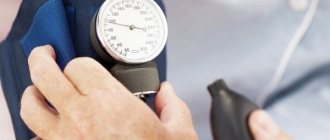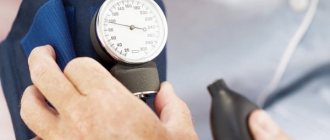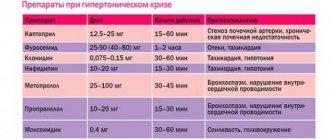To measure blood pressure (BP), automatic or mechanical tonometers are used, which can be purchased at any pharmacy. Self-monitoring and keeping a blood pressure diary motivates the patient to comply with all doctor’s recommendations and increases the effectiveness of treatment by 20%. We highly recommend bringing your BP diary to every doctor's visit.
When measuring blood pressure, a number of conditions must be met:
- Blood pressure must be measured in a sitting position. It is advisable to lean on the back of a chair and relax your legs.
- The hand on which the measurement is being taken should lie freely on the table, without tension.
- The measurement is carried out after a 10-15 minute rest, 2-3 times a day, at approximately the same time. The measurement must be taken twice with a break of 2-4 minutes.
- Initially, the measurement is carried out on both arms in order to identify the arm on which the blood pressure is higher (usually the difference is 5-10 mmHg). In the future, measurements are carried out on the hand on which it turned out to be higher.
- It is advisable not to talk while measuring blood pressure.
- 1 hour before measurement, you should avoid eating and smoking.
- The blood pressure cuff should be the right size for you.
- The lower edge of the cuff should be located 1-2 cm above the elbow.
Measuring blood pressure using the auscultatory method (Korotkoff method) with a mechanical tonometer using a stethoscope requires compliance with several additional rules:
- It is necessary to install the head of the stethoscope 1-2 cm inward from the center of the cubital fossa.
- It is enough to quickly pump air into the cuff; the inflation level should be 20-30 mm. rt. Art. higher than “normal” blood pressure.
- You need to deflate the air from the cuff slowly at a speed of 3-4 mm. rt. Art. per second.
- Record the appearance of the first Korotkoff sound - this will be the systolic blood pressure.
- Record the disappearance of Korotkoff sounds; this corresponds to diastolic blood pressure.
It is important to know!
When measuring blood pressure with any tonometer, mechanical or automatic, with an interval of 2-3 minutes, the values may turn out to be slightly different.
Differences in tonometer readings should not be regarded as manifestations of inaccuracy or malfunction of the devices. The value of blood pressure, like all other parameters of the body, is not constant and is within the limits of physiological fluctuations.
It is also necessary to remember that with physical activity blood pressure increases. This is a physiological mechanism; when the load is stopped, blood pressure normally decreases after a few minutes.
A little about pressure
Blood pressure levels are expressed as two numbers, written as a fraction. The numbers mean the following: at the top is systolic pressure, which is popularly called upper, at the bottom is diastolic, or lower. Systolic is recorded when the heart contracts and pushes out blood, diastolic - when it relaxes to its maximum. The unit of measurement is millimeter of mercury. The optimal blood pressure level for adults is 120/80 mmHg. pillar Blood pressure is considered elevated if it is more than 139/89 mmHg. pillar
A condition in which its level remains consistently high is called hypertension, and a stable decrease is called hypotension. The difference between the upper and lower should be 40-50 mmHg. Blood pressure changes throughout the day for all people, but in hypertensive patients these fluctuations are much sharper.
Table of norm indicators
Each person, depending on many factors, develops his own working pressure, it is individual. The upper limit of normal is 135/85 mmHg. Art. The lower limit is 95/55 mm Hg. Art.
Blood pressure greatly depends on age, gender, height, weight, and the presence of diseases.
| Systolic pressure, mm Hg. Art. | Diastolic pressure, mm Hg. Art. | Age |
| 60–95 | 40–60 | up to 2 weeks |
| 85–115 | 55–70 | up to 3 years |
| 100–120 | 60–80 | 4–9 years |
| 110–130 | 65–80 | 10–15 years |
| 100–130 | 65–80 | 16–20 years old |
| 120–135 | 70–85 | 21–40 years old |
| 125–140 | 75–90 | 41–59 years old |
| 130–140 | 80–90 | over 60 years old |
Why do you need to know your blood pressure?
Even a slight increase in blood pressure increases the risk of heart attack, stroke, ischemia, heart and kidney failure. And the higher it is, the greater the risk. Very often, hypertension in the initial stage occurs without symptoms, and a person is not even aware of his condition.
Measuring blood pressure is the first thing to do if you complain of frequent headaches, dizziness, or weakness.
Hypertensive patients should measure their blood pressure every day and monitor its level after taking the pills. People with high blood pressure should not sharply reduce it with medications.
Recommendations for intravascular measurement technology
It doesn’t matter at all whether your blood pressure is measured with a mechanical or automatic tonometer, or what the device for measuring a person’s blood pressure is called: shoulder, finger or wrist. It will be necessary to measure intravascular tension correctly, otherwise even the best devices will show an erroneous result.
- The test is carried out on an empty bladder, because the desire to visit the bathroom provokes intravascular tension.
- Whatever device you use, a sitting position will be required. You need to lean your elbows on the back of the chair and not cross your legs, but place them firmly on the floor.
- Devices for measuring a person’s blood pressure, namely cuffs, are put on the bare arm so that clothing does not create additional compression.
To protect yourself from the progression of intravascular diseases, you should consult with a specialist and find out how blood pressure is measured in your case.
This reduces the risk of complications such as heart attack, stroke and hypertensive crisis. The patient should regularly monitor his own intravascular condition to ensure a competent approach to therapeutic therapy and the return of blood vessels to normal.
Methods for measuring blood pressure
Blood pressure levels can be determined directly and indirectly.
Straight
This invasive method is highly accurate, but it is traumatic because it involves directly inserting a needle into a vessel or cavity of the heart. The needle is connected to the pressure gauge by a tube containing an anti-clotting agent. The result is a curve of blood pressure fluctuations recorded by a scribe. This method is most often used in cardiac surgery.
Indirect methods
Typically, pressure is measured in the peripheral vessels of the upper extremities, namely in the elbow bend of the arm.
Nowadays, two non-invasive methods are widely used: auscultatory and oscillometric.
The first (auscultatory), proposed by the Russian surgeon N. S. Korotkov at the beginning of the 20th century, is based on clamping the shoulder artery with a cuff and listening to the tones that appear when air is slowly released from the cuff. Upper and lower pressure are determined by the appearance and disappearance of sounds that are characteristic of turbulent blood flow. Blood pressure measurement using this method is carried out using a very simple device consisting of a pressure gauge, a phonendoscope and a cuff with a pear-shaped balloon.
When measuring blood pressure in this way, a cuff is placed on the shoulder area, into which air is pumped until the pressure in it exceeds systolic pressure. At this moment, the artery is completely pinched, the blood flow in it stops, and no sounds are heard. As the cuff begins to deflate, the pressure decreases. When the external pressure is compared with the systolic pressure, blood begins to pass through the compressed area, noises appear that accompany the turbulent flow of blood. These are called Korotkoff sounds and can be heard with a phonendoscope. At the moment when they occur, the value on the pressure gauge is equal to systolic blood pressure. When the external pressure is compared with the arterial pressure, the sounds disappear, and at this moment the diastolic pressure is determined using the manometer.
To measure Korotkoff blood pressure, a mechanical tonometer is used.
The microphone of the measuring device picks up Korotkoff sounds and converts them into electrical signals, which are sent to a recording device, on the display of which the values of the upper and lower blood pressure appear. There are other devices in which the arising and disappearing characteristic noises are determined using ultrasound.
The Korotkoff blood pressure measurement method is officially considered a standard. It has both pros and cons. Among the advantages include high resistance to hand movement. There are several more disadvantages:
- Sensitive to noise in the room where measurements are taken.
- The accuracy of the result depends on whether the head of the phonendoscope is correctly positioned and on the individual qualities of the person measuring blood pressure (hearing, vision, hands).
- Skin contact with the cuff and microphone head is required.
- It is technically complex, which causes errors in measurements.
- This requires special preparation.
Oscillometric With this method, blood pressure is measured with an electronic tonometer. The principle of this method is that the device registers pulsations in the cuff, which appear when blood passes through a compressed area of the vessel. The main disadvantage of this method is that the hand must be motionless when measuring. There are quite a lot of advantages:
- No special training is required.
- The individual qualities of the person measuring (vision, hands, hearing) do not matter.
- Resistant to noise present in the room.
- Determines blood pressure with weak Korotkoff sounds.
- The cuff can be worn over a thin jacket, and this does not affect the accuracy of the result.
St. Petersburg State Budgetary Healthcare Institution "Polyclinic No. 98"
Blood pressure level is one of the clearest indicators of health status. True, most often the need to monitor blood pressure is remembered in diseases of the cardiovascular system. In fact, everyone should know everything about their blood pressure, because it changes for various reasons.
What is blood pressure?
Blood pressure (BP) is the pressure that blood exerts on the walls of the arteries. It is uneven and fluctuates depending on the phase of the heart. During systole, when the heart contracts and releases another portion of blood into the vessels, the pressure increases. And in diastole, when the heart relaxes and fills with blood, the pressure in the arteries decreases. The blood pressure on the walls of the arteries in systole is called “upper” or systolic, and in diastole – “lower” or diastolic. It is customary to write the blood pressure value using a fraction: the first is the upper, the second is the lower.
Blood pressure is one of the most important indicators of the cardiovascular system. In most healthy people it is relatively constant. But under the influence of stress, physical activity, overwork, drinking large amounts of liquid and under the influence of other factors, its value may change. Typically, such changes are either not too frequent or not too strong, and do not exceed 20 mm during the day. rt. Art. – for systolic, 10 mm. rt. Art. – for diastolic. But, a repeated or persistent decrease or increase in pressure beyond the normal range may be an alarming signal of illness and requires immediate consultation with a doctor.
Blood pressure standards according to WHO classification
| Blood pressure (category) | Upper blood pressure (mm Hg) | Lower blood pressure (mm Hg) |
| Hypotension (low) | below 100 | below 60 |
| Optimal pressure | 100–119 | 60–79 |
| Normal pressure | 120–129 | 80–84 |
| High normal pressure | 130–139 | 85–89 |
| Moderate hypertension (increased) | 140–159 | 90–99 |
| Moderate hypertension | 160–179 | 100–109 |
| Severe hypertension | more than 180 | more than 110 |
The ideal “cosmonaut pressure” is 120/80 mm. rt. Art. However, many doctors agree that everyone has their own ideal, and therefore often ask about the patient’s “working” pressure. Working blood pressure is the usual constant blood pressure interval that provides a person with good health. Since this interval is individual, for someone 115/80 with a working 130/90 may be lower, although it falls within the normal range. And, conversely, with a working level of 110/80, 130/90 may become elevated. Knowing the working pressure helps the doctor to timely identify pathology, make a more accurate diagnosis and choose the right treatment.
However, it is worth remembering that pressure beyond the lower and upper limits of the norm is not working for a healthy person. And feeling normal in this case is only an additional reason to seek advice from a specialist.
Who needs to monitor blood pressure levels and how?
One of the most common disorders of blood pressure regulation is hypertension. Often behind it lies hypertension, leading to myocardial infarction, stroke and other serious complications. Unfortunately, arterial hypertension is often asymptomatic, so everyone needs to monitor their blood pressure. People who are prone to increasing it, who are exposed to risk factors for developing hypertension and experiencing its symptoms should be especially careful and measure blood pressure from time to time. For the rest, annual monitoring during the medical examination period is quite sufficient. But for those who have been diagnosed with arterial hypertension, it would be good to make friends with a tonometer and check the pressure level at least twice a day - in the morning and in the evening.
It is imperative to measure blood pressure if you experience weakness, dizziness, headache, darkening, “veil” in the eyes, tinnitus, difficulty breathing, pain and heaviness in the heart area or behind the sternum, or when other symptoms appear that usually accompany an increase or decrease in pressure.
It is also worth monitoring blood pressure during exercise, especially when selecting a load.
How to measure blood pressure correctly?
If the blood pressure measurement is planned, then one hour before the measurement you should not drink alcohol, drinks containing caffeine (tea, cola, coffee) or smoke, and five minutes before the measurement, ensure yourself a state of rest.
At the first visit to the doctor, the pressure is measured on both arms alternately. If the results differ by more than 10 mm. rt. Art., then the subsequent measurement is carried out on the arm with a high blood pressure value. However, normally the readings are approximately the same. The difference between them exceeds 10 mm. rt. Art., indicates an increased risk of diseases of the cardiovascular system and death from them or an existing pathology.
Blood pressure is usually measured while sitting or lying down. The hand on which the measurement is taken should be freed from clothing and compressive objects, relaxed and motionless. To avoid unwanted tension, it can be placed on an object that provides a support point, such as a table or the edge of a bed. It is best to position the limb so that the elbow is at the level of the heart. The arm should not have arteriovenous fistulas for dialysis, traces of a section of the brachial artery, or lymphedema.
The cuff is placed on the shoulder 2 cm above the elbow. It is important that it fits your hand tightly, but does not squeeze it.
Ideally, blood pressure is measured twice with an interval of 2 minutes. If the result differs by more than 5 mm. rt. Art. – after 2 minutes, take the third measurement and calculate the average value.
The method of measuring pressure depends on the device used and is indicated in the operating instructions.
How to choose a pressure measuring device?
The device for measuring pressure is called a tonometer. There are two types of tonometers - mechanical and electronic (automatic and semi-automatic).
A mechanical tonometer is inexpensive, reliable, lasts a long time, guarantees high measurement accuracy, is easy to use, but requires certain skills and is more difficult to use without assistance.
The electronic tonometer is convenient and simple; you can easily use it yourself. In addition to devices that measure pressure on the shoulder, there are also those that measure it on the wrist. This tonometer can be carried with you, which is sometimes important for some hypertensive patients. And devices with large dials come in very handy for older people. Many of the electronic tonometers show the pulse, remember the data of the latest measurements and are equipped with some other functions, the quantity and quality of which largely depends on the price of the device. But automatic and semi-automatic devices are more expensive than mechanical ones, less accurate and may last slightly less. In addition, in some diseases, blood pressure is very difficult to measure with an electronic tonometer, for example, with atrial fibrillation.
When purchasing a tonometer, you must pay attention to the presence of instructions in Russian, a passport of the device, a warranty card and the absence of visible defects. And when purchasing an electronic device, it also depends on the country of origin. Japanese and German devices are traditionally considered the best.
If the choice falls on a mechanical tonometer, it is worth remembering that it requires a phonendoscope. It is often not included in the package.
It is best to buy pressure measuring devices at a pharmacy or specialty store. If the device is purchased secondhand, the accuracy of the measurement and its service life cannot be guaranteed.
The average width of the cuff should be 13–17 cm, for children - a little less, for overweight people - a little more.
Before use, the tonometer should be checked and, if necessary, adjusted. It is easier and more correct to do this with the help of a doctor.
How to measure blood pressure with a mechanical tonometer?
Not everyone can measure pressure independently with a mechanical tonometer, so the help of another person is advisable.
In addition to a tonometer, you will need a phonendoscope for measurements.
A phonendoscope is a device for listening to sounds accompanying the work of internal organs. It consists of a “head” that is applied to the body, tubes that conduct sound, and tips that are inserted into the ears.
Measurement procedure:
- A cuff is placed on the shoulder, 2 cm above the elbow.
- The pulse is determined at the radial artery at the wrist.
- Air is quickly inflated into the cuff. After the pulse disappears, the cuff is inflated by another 30–40 mm Hg. Art.
- The head of a phonendoscope is placed along the lower edge of the cuff in the elbow bend, slightly inward from the center of the ulnar fossa.
- The air from the cuff is slowly released at a speed of 2-3 mmHg. Art. in 1 s. In this case, the instrument scale is constantly under control. The scale value at which the first sound appears is considered the systolic pressure value, and the value at which it disappears is considered the diastolic pressure value.
- When the pulse wave beats become inaudible, the air from the cuff is quickly released.
Measuring blood pressure with an electronic tonometer for a specific device may have its own subtleties and is described in detail in the operating instructions.
Types of tonometers
Today, aneroid (or mechanical) devices and electronic ones are used to determine blood pressure.
The former are used to measure pressure using the Korotkoff method in a medical facility, since they are too complex for home use, and untrained users receive results with errors when taking measurements.
An electronic device can be automatic or semi-automatic. Such tonometers are intended for daily home use.
Anyone can use an electronic tonometer to measure their own blood pressure and pulse.
Price
Several factors influence pricing:
- Brand. The more popular and advertised the manufacturer is, the higher the price will be.
- Design. New models are always more expensive than outdated ones. They look more modern, are often more compact than their predecessors and have more functionality. In a sense, there is also a fashion in the field of medical devices.
- Additional functions. Expensive models of electronic tonometers are equipped with functions for storing a certain number of measurements, detecting arrhythmia, motion and position indicators, and alert signals. A clock, calendar and thermometer can be built-in.
- Type of tonometer. Mechanical is the most budget option (~ 1000 rubles). Semi-automatic blood pressure monitors are more expensive – from 1200 rubles. Automatic blood pressure monitors can cost from 1800 rubles and more.
General rules for measuring blood pressure
Blood pressure is most often measured while sitting, but is sometimes done while standing or lying down.
People's daily blood pressure is constantly changing. It increases with emotional and physical stress. It can be measured not only in a calm state, but also during physical activity, as well as in breaks between different types of loads.
Since blood pressure depends on a person's condition, it is important to provide the patient with a comfortable environment. The patient himself needs to not eat, not engage in physical labor, not smoke, not drink alcoholic beverages, and not be exposed to cold for half an hour before the procedure.
During the procedure, you should not make sudden movements or talk.
It is recommended to take measurements more than once. If a series of measurements is made, between each approach you need a break of about one minute (at least 15 seconds) and a change of position. During the break, it is recommended to loosen the cuff.
The pressure on different hands can vary significantly; therefore, measurements are best taken on the one where the level is usually higher.
There are patients whose blood pressure is always higher in the clinic than when measured at home. This is explained by the excitement that many feel when they see medical workers in white coats. For some, this can happen at home as well, as a reaction to measurement. In such cases, it is recommended to take measurements three times and calculate the average value.
Choosing a hand for measuring blood pressure
Many people are concerned about the question: on which hand the pressure is measured, because the accuracy of the final numbers may depend on this. Doctors advise taking measurements on both limbs, and then doing another circle. Before measuring the pressure 2 times, you need to wait 3-4 minutes. The results obtained should be recorded. They will help you choose which arm to measure the pressure on correctly, since from now on it will be possible to carry out the procedure on the limb on which the readings were too high.
Sometimes blood pressure readings in both limbs are the same. In this case, you can understand on which hand to measure the pressure based on other criteria, for example, whether a person is right-handed or left-handed.
If the right limb is used predominantly, then the measurement should be carried out on the left, and vice versa.
The procedure for determining blood pressure in different categories of patients
In the elderly
This category of people often experiences unstable blood pressure, which is associated with disturbances in the blood flow regulation system, decreased vascular elasticity, and atherosclerosis. Therefore, elderly patients need to take a series of measurements and calculate the average value.
In addition, they need to measure their blood pressure while standing and sitting, since they often experience a sharp drop in blood pressure when changing positions, for example, when getting out of bed and sitting.
In children
It is recommended that children measure blood pressure with a mechanical tonometer or an electronic semi-automatic device, and use a children's cuff. Before measuring your child’s blood pressure yourself, you need to consult with your pediatrician about the amount of air pumped into the cuff and the measurement time.
In pregnant women
Blood pressure can tell you how well your pregnancy is going. For expectant mothers, it is very important to constantly monitor blood pressure in order to start treatment on time and avoid serious complications in the fetus.
During pregnancy, blood pressure monitoring is mandatory
Pregnant women need to measure their blood pressure while reclining. If its level exceeds the norm or, conversely, is much lower, you should immediately consult your doctor.
For cardiac arrhythmia
People who have irregular heartbeat sequence, rhythm and frequency should measure their blood pressure several times in a row, discard clearly incorrect results and calculate the average value. In this case, the air from the cuff must be released at a lower speed. The fact is that with cardiac arrhythmia, its level can vary significantly from beat to beat.
Situations in which there is a large difference in blood pressure
Often the problem is that a person does not know how to measure blood pressure correctly. Even if you don’t read the information on the Internet or consult a doctor, the box with each tonometer comes with instructions for measurement, but few people read it.
In more rare cases, the situation is aggravated due to the fact that the person does not understand which arm to measure blood pressure on and constantly does it on different limbs. Gradually, the difference in blood pressure begins to increase, but the patient will not know about it until visible symptoms occur.
Situations associated with pressure differences are as follows:
- One limb has normal pressure and the other has high pressure. In this case, the problem often lies in the development of VSD and anatomical abnormalities of the aorta and other arteries supplying the arms.
- High blood pressure on one limb and even higher on the other. This situation occurs due to the development of hypertension, VSD, as well as due to stress, overload and lack of sleep.
- Low pressure on one limb and high or normal pressure on the other. In this case, we are often talking about blockage of the artery or its compression.
The situations listed above do not arise immediately, but only after a long time. That is why it is important not only to understand on which arm the pressure should be measured, but also to periodically carry out the procedure on both limbs. In this case, the occurrence of many pathologies can be avoided.
Blood pressure measurement algorithm
Blood pressure measurements should be taken in the following order:
- The patient is seated comfortably on a chair so that his back is adjacent to the back, that is, has support.
- The hand is freed from clothing and placed on the table with the palm up, placing a roll of a towel or the patient’s fist under the elbow.
- A blood pressure cuff is placed on the bare shoulder (two to three centimeters above the elbow, approximately at heart level). Two fingers should fit between the hand and the cuff, its tubes pointing down.
- The tonometer is at eye level, its needle is at the zero mark.
- Find the pulse in the ulnar fossa and apply a phonendoscope to this place with slight pressure.
- The valve on the tonometer bulb is screwed on.
- The pear-shaped balloon is compressed and air is pumped into the cuff until pulsation in the artery can no longer be heard. This occurs when the pressure in the cuff exceeds 20-30 mmHg. pillar
- Open the valve and release air from the cuff at a speed of about 3 mmHg. pillar, while listening to Korotkoff sounds.
- When the first constant tones appear, record the pressure gauge readings - this is the upper pressure.
- Continue to release air. As soon as the weakening Korotkoff sounds disappear, the pressure gauge readings are recorded - this is the lower pressure.
- Release air from the cuff, listening to sounds, until the pressure in it becomes equal to 0.
- Allow the patient to rest for about two minutes and measure blood pressure again.
- Then remove the cuff and record the results in a diary.
Correct position of the patient during blood pressure measurement
Hand-held device
A manual tonometer for measuring pressure is an air-filled cuff with Velcro, connected by hoses to a rubber pump - a bulb and a meter (manometer). The cuff is wrapped around the patient's shoulder and fastened. The bulb is equipped with a screw-on valve. By compressing it several times, air is pumped into the cuff.
The most common breakdown of a mechanical tonometer is a violation of the seal of the bulb: the bulb bursts, or an invisible crack appears on it over time, which requires replacement of this part of the device.
In addition, some devices come with a phonendoscope for listening to blood impulses in the arteries. These blood pressure monitors are certainly more convenient.
Wrist blood pressure measurement technique
To measure blood pressure at the wrist with an electronic device with a cuff, you must follow the following instructions:
- Remove watches or bracelets from your wrist, unbutton the sleeve and fold it back.
- Place the tonometer cuff 1 centimeter above the hand with the display facing up.
- Place the hand with the cuff on the opposite shoulder, palm down.
- With your other hand, press the “Start” button and place it under the elbow of your cuffed arm.
- Remain in this position until the air is automatically released from the cuff.
This method is not suitable for everyone. It is not recommended for people with diabetes, atherosclerosis and other blood supply disorders and changes in the vascular walls. Before using such a device, you need to measure the pressure with a tonometer with a cuff on the shoulder, then with a cuff on the wrist, compare the obtained values and make sure that the difference is small.
A wrist blood pressure monitor has both advantages and disadvantages.
What to consider when measuring pressure
- Stress can significantly change the readings, so you need to measure it in a calm state.
- Blood pressure increases with constipation, immediately after eating, after smoking and drinking alcohol, with excitement, and in a sleepy state.
- It is best to carry out the procedure one to two hours after eating.
- Blood pressure should be measured immediately after urination, since it is elevated before urination.
- The pressure changes when taking a shower or bath.
- A nearby mobile phone can change the tonometer readings.
- Tea and coffee can change blood pressure.
- To stabilize it, you need to take five deep breaths.
- It increases when you are in a cold room.











